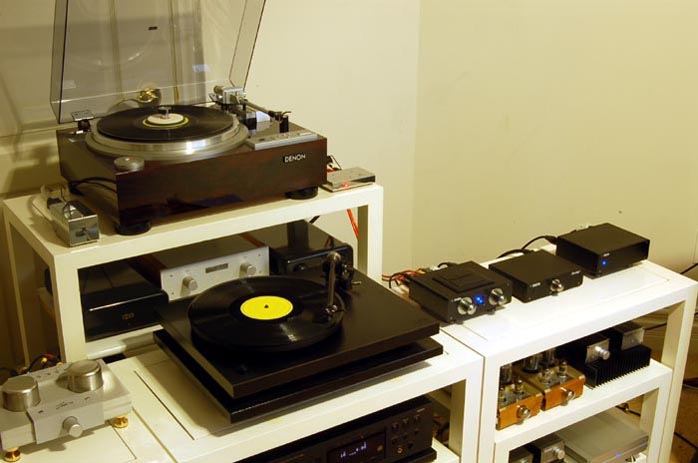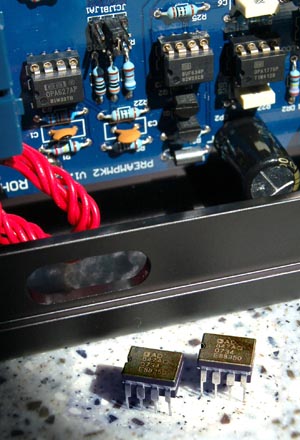This review page is supported in part by the sponsors whose ad banners are displayed below |
 |
Let’s start with my favorite system in recent months - NuForce Reference 9 V2 SE + Dynaudio Facette. Rated output of the NuForce is 300wpc into 4 ohms and that should be ample to drive the 4-ohm Facette. To make sure I get 100% from my amps, I need √(300 x 4) = 34.64V (AC) current to feed the loudspeaker. To get 34V I need 1.7V from the source and 20 times total gain from preamp + power amp (1.7V x 20 = 34V). Thus far, I had used the Audio Zone Pre-T1 passive preamp set to 6dB (x2) gain. Combining the 27dB (approximately x10) gain from the NuForce monoblock, that fit the x 20 gain demand of the above equation. But I don’t think the Marantz SA8260 puts out 1.7V at all, let alone 2.2Vrms as claimed. From a mathematical point of view, the system lacks gain but strangely enough, I was content. It’s the quality that counts, not quantity.
|
 |
Before the actual audition commenced, I still had to determine the optimal gain setting for the PREference to work with the 27dB gain NuForce monoblocks driving the 84dB low-sensitivity Facette. I first started off with medium 14dB gain. A great CD that arrived just in time was the Great Movie Themes 2 with Carl Davies conducting the Royal Liverpool Philharmonic Orchestra [Naxos 8.572111]. With volume at 10:30, the explosive percussion group in “Mission Impossible” maintained a fine balance with the string section and the brass section behind that for exuberance without dominance. Equally well-proportioned was instrumentation in “Love Story” with a well-defined piano solo, delicate percussive ornamentation and swirling strings. Pushing up to 20dB high gain and dialling back the volume knob to 9:15, no pixellated grain was evident, with smoothness and finesse well preserved. Piano solo was focussed and microdynamics were admirable.
The real test—I presumed—would be the 7dB low gain setting but to my surprise, I only needed to reach 11:15 to get sufficiently loud listening levels. An even bigger surprise was that the dynamics and transient bursts were not discounted at all. On the contrary, they seemed to display better definition through orchestral climaxes whereas instruments had more air around them and seemed less congested. In other words, imaging was more holographic. As it turned out, the most unexpected was the most eligible and that became the setting I would use for the comparative audition. Naturally, I set the Audio Zone Pre-T1 to the 6dB transformer gain (volume knob at 12:30 – 1:00) for fair play.
|
|
|
Audio Zone served first. The complex “Batman” tutti was well disciplined and unconvoluted. The string timbres in “Can you read my mind?” were as pure as spring water. Switching back to The Nordic Sound from 2L, the soundstage was deep and ambience natural in Mozart’s Violin Concerto. Cikada Duo’s percussion piece was electrifying and the Pre-T1 didn’t compromise on punch like some passive preamps do. The low octaves seemed a bit less forceful but that might have been perceptual due to the clean-cut high-definition presentation. I could boost the bass if I set gain to 0dB and the volume to 4:00 or even full throttle but clarity would be sacrificed.
Speaking of high-definition sound, I put on the Mendelssohn/Debussy String Quartets SMRD Studio Master Reference Disc [Unipheye UM-0205] with my 24Bit/192kHz HD audio ready LG notebook as digital source. If I said the Pre-T1 was too objective, I was being polite. Although articulation was still there and every bowing stroke and pizzicato could be witnessed, the SMRD somehow seemed too rational for my passive preamp. To a certain extent, I had a similar gripe with drier recordings like certain Decca ADRM reissues and Mercury CDs.
|
 |
Concluding thoughts: Getting personal - While the passive preamp presented music with utter transparency and mobilized the amplification force in an orderly manner, the PREference portrayed the same with more artistic flair. Another word would be personal touch. The KingRex team demonstrated one thing crucial for preamps: adaptability. Be it CD, SACD or SMRD (and before I forget, LP), the PREference has achieved a fine balance between textural detail, harmonic richness and tonal coherence across the full range. With the PREference, you can add your own personal touch by rolling op amps, even those for the phono stage. I tried rolling the preamp-stage Burr Brown OP627 with Analog Device AD847 and took detailed notes which I don’t intend to get into here.
All I’ll say is that in my system, I prefer the factory-fitted OPA627 for more inner detail and dynamics, richer piano sonority with glowing sheen (especially in super high and mid range), more exquisite string textures with more refined resolution (I could feel the abrasion of bow attacks) and tighter and cleaner bass. On the other hand, the AD847 was smoother, mellower and more musical – but the OPA627 is not a-musical. It just reveals more information. My Marantz SA6820 is very musical itself and might just need the help of the OPA627 to carve out all the details. |
|
We will never agree on the best preamp in the world because we are all looking for that subtle personal touch from various designers to strike the chord in our hearts - that right amount of voicing, that correct level of color saturation for that particular synergy. With the PREference and the many user-selectable options it offers from gain to capacitance, from op amp to buffer rolling, you are one step closer to finding that perfect synergy. And with this pricing, who cares if money is object or not? |
|
|
|
Quality of packing: Presentation box with foam cradle, outer carton box for shipping.
Reusability of packing:Yes.
Ease of unpacking/repacking:Entirely unproblematic.
Condition of component received: Flawless.
Completeness of delivery: Shipped with AC power cord, isolation spikes and discs.
Quality of owner's manual: Standard.
Website comments: Needs improvement.
Warranty: One year.
Global distribution: Taiwan, Japan, Singapore, Australia, New Zealand, Canada, U.S.A., Denmark, Finland, France, Germany, Greece, Italy, Netherlands, Switzerland.
Human interactions: Professional and courteous, timely responses to questions, adequate English skills despite being non-native English speakers, forthcoming about technicality and everything.
Pricing: Thorough R&D and flawless implementation make it hard to resist. The phono board is a steal!
Application conditions: Highly adaptable with many gain settings and op amp rolling possibilities. The seemingly restrictive choice for MC resistive load will suit most cartridges and is not a concern.
Final comments & suggestions: Highly recommended for first-time vinylstas and those seriously thinking of upgrading their preamps.
|
|
 |
 |
|